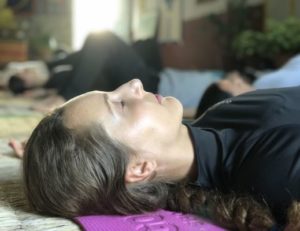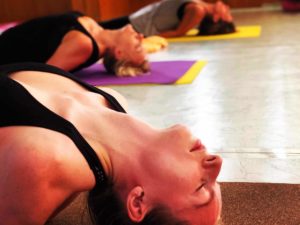We are stressed day and night. We eat, sleep, and dream stress, thus we become stress. Several practices promise stress-relief; from adaptogens for adrenal fatigue to exhausting the body through strenuous physical exercise. Cognitive therapy, mindfulness practices, art therapy, breathwork, and meditative practices have excellent results. But time and time again, yoga reigns supreme. While the aforementioned activities could be used in conjunction with yoga, there is a special brand of yoga that is reaping all the benefits and drastically reducing stress by tenfold. Restorative yoga is finding a place in homes across the globe as stress levels go through the roof. And it’s a good thing, too, because stress is the underlying cause for the majority, if not all, of modern human disease and illness.
Locate where the body holds tension
When we tune into where stress exists, we get closer to peeling back another layer of our pain and suffering. Stress is suffering. It is not natural to the body unless in flight or fight mode. Pinpointing where stress dwells gives us a better opportunity to know our bodies and read our triggers. Then we can apply proper techniques to remove tension through restorative yoga poses.
Release stored trauma and stress
Restorative yoga has plenty of benefits, but one that speaks to the masses is its ability to remove stored trauma and built-up stress. The poses maintain the body in order to listen to the body. While immobile in a pose, through relaxation and deep breathing, the body begins to surrender. In surrender postures, we give permission for the body to let go of that which no longer serves us.
Allow room for deep breathing
Deep breathing fosters relaxation. It is one of the main focal points of restorative yoga. Listening to the breath, making it deeper, and using it to push into and beyond a specific pose are keys to receiving the benefits of restorative yoga. Don’t be shy to breathe with purpose, allow others to hear the breath, and give self over to the power of the breath. We prosper greatly in any yoga, especially restorative Yoga when we allow the breath to do the work for us.
Build awareness in the mind and body simultaneously
Holding a restorative yoga pose opens up space for awareness. We pay attention to the body’s signals and sensations while at the same time listening to what the mind says about the posture. The mind is a trickster, it will tell us to escape the pose, it will want us to seek comfort, it will tell us the body is weak or hurting. We must be the masters of our minds and build awareness between the two. When the mind tries to manipulate us, we have to ask bigger questions like why, what’s happening here, and remind ourselves that with time all things change. Nothing is permanent.
Benefits of restorative Yoga -Increase flexibility
Restorative yoga increases flexibility because it uses breath, gravity, and extended time periods during each pose. Within a few sessions, restorative yoga practitioners have noted a change in their levels of flexibility. The triad of techniques mentioned is what target muscles, tendons, and joints on a very deep level. Restorative yoga aims to tap into those areas for soft, supple bodies free of stress.
Soothes the nervous system and boost the immune system
Stress triggers the nervous systems which directly affects our immune system. In order to balance both and seek ultimate homeostasis, restorative yoga is necessary. Practicing restorative yoga at night is recommended as an end of the day cleanser, a way to prepare for a restful, full night’s sleep. As we decrease our levels of stress through restorative yoga, the body and all its systems adjust naturally. And we can dwell in our bodies with greater appreciation knowing we’re caring for each system.
Cultivate deeper levels of consciousness Because restorative yoga delves deep into the tissues and peels back emotional layers of the body, it’s working on our consciousness. Spending a long time period in a pose, using the breath as a catalyst to go deeper, and moving beyond the mind and body we tap into the abyss of our soul. It starts to feel like a oneness when we reach a certain level of awareness and once we are there, we cultivate a universal consciousness that has the potential to do great things like change the vibration of the world, heal and uncover the joy of samadhi.



